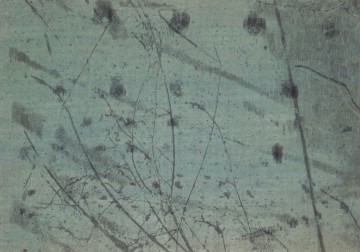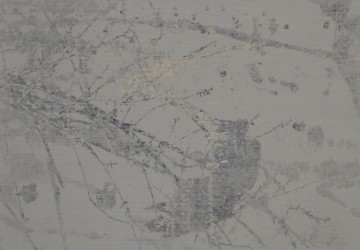Othmar Eder
AN DEN FLUSS
March 18, 2011 – April 30, 2011
During his travels Eder has been distinguished over and over as a sensible collector and observer. Sharp eyed, he detects the slowness and the unspectacular beauty of the surrounding reality, and then puts his finger and pencil on phenomenons which deprive themselves of superficial glances. With a unique persistence and endurance he turns towards little shoals and trivia and tracks down all the more depth and relevance.
Eder‘s first video in ‘Durch den Wald’ revealed his visual recording process. The slow tracking shot along a rock surface scanned the smallest crack and created essentially a graphical image. In his new video ‘River’ the moving object goes ahead and virtually grabs the pencil. By monitoring and recording rivers and waters he reveals how they manage to draw an image by their own movement. So Eder remains with no camera panning on the Hudson river looking at poles that barely stick out of the water. Soft waves flood them for a short moment whereupon the poles disappear from the screen. This process creates an unspectacular beauty of black and white images that come and go with the rhythm of the flow.
As already seen in previous works, Eder continues to detach single objects or scenes in order to examine them at a closer distance. Such as drawn film stills, sometimes only seconds apart, that are lined-up, alternating with loosely inserted drawings and boards. Or the two works of the diptychon with an image of a shepherd that differ only slightly from each other. A close look, however, reveals a little shift in time. Such as small blurs, shifts and repetitions that he examines and documents with an almost scientific precision is exactly the focal point of Eder‘s interest. ‘An den Fluss’ brings motion into Eder‘s world and arouses curiosity for the next part ‘In die Stadt’.
Eder‘s first video in ‘Durch den Wald’ revealed his visual recording process. The slow tracking shot along a rock surface scanned the smallest crack and created essentially a graphical image. In his new video ‘River’ the moving object goes ahead and virtually grabs the pencil. By monitoring and recording rivers and waters he reveals how they manage to draw an image by their own movement. So Eder remains with no camera panning on the Hudson river looking at poles that barely stick out of the water. Soft waves flood them for a short moment whereupon the poles disappear from the screen. This process creates an unspectacular beauty of black and white images that come and go with the rhythm of the flow.
As already seen in previous works, Eder continues to detach single objects or scenes in order to examine them at a closer distance. Such as drawn film stills, sometimes only seconds apart, that are lined-up, alternating with loosely inserted drawings and boards. Or the two works of the diptychon with an image of a shepherd that differ only slightly from each other. A close look, however, reveals a little shift in time. Such as small blurs, shifts and repetitions that he examines and documents with an almost scientific precision is exactly the focal point of Eder‘s interest. ‘An den Fluss’ brings motion into Eder‘s world and arouses curiosity for the next part ‘In die Stadt’.


